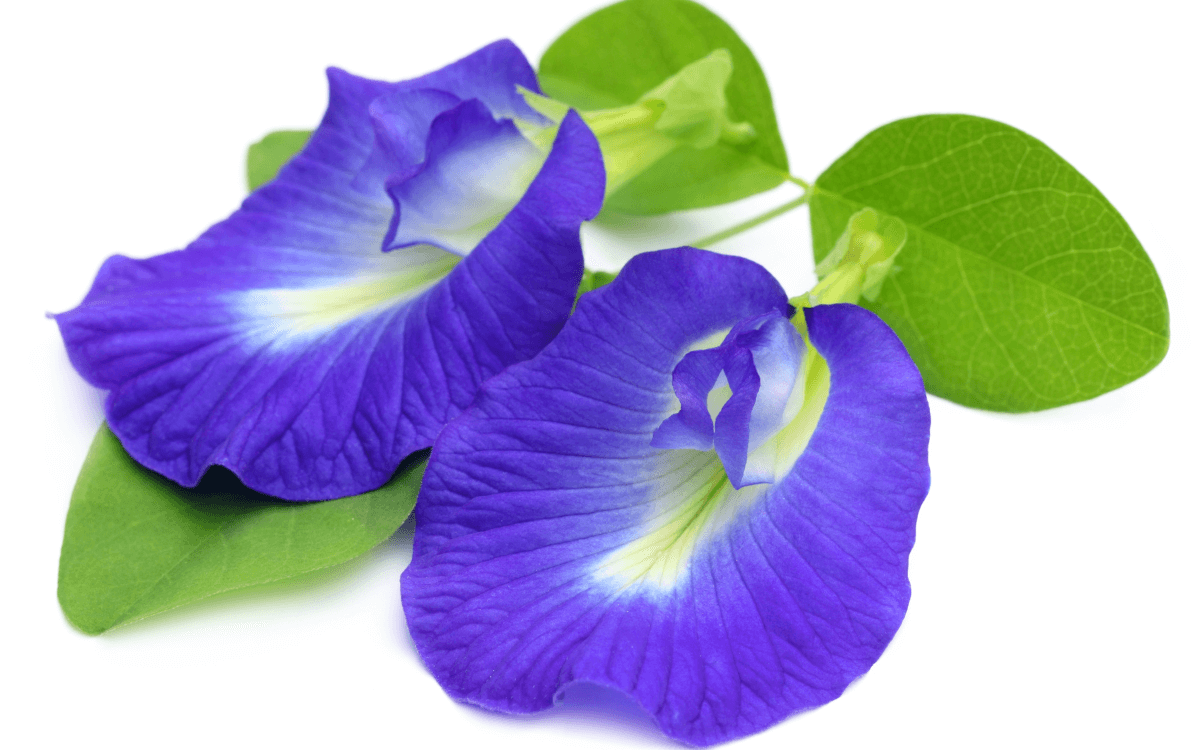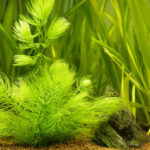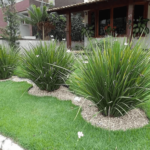The Clitoria ternatea is a plant that attracts attention due to its beauty and medicinal properties.
Popularly known as butterfly pea, asian pigeonwings, bluebellvine or Darwin pea this plant is native to tropical locations in Asia, particularly found in Thailand and Malaysia.
The Clitoria ternatea plays a crucial role both in Ayurvedic tradition and in modern culinary and natural medicine.
In this article, we will discuss a little more about it.
Characteristics
Named by Carl Linnaeus and belonging to the legume family, Clitoria ternatea is a perennial vine that can grow up to 3 meters (about 10 feet) in length.
The flowers of this plant are a very dark blue, almost purple, and the inside of the flowers is white, creating a beautiful contrast.
The leaves are green and shiny, which matches very well with the vibrant colors of the flowers. You can find this plant with flowers of a simple shape or more elaborate ones, with several layers.
This makes it a very popular choice for decorating gardens.
Medicinal and Therapeutic Uses
Before using any plant as treatment, it is essential to consult a doctor. The information below is for your knowledge only and does not replace professional medical advice.
Clitoria ternatea has extensively valued medicinal properties.
Traditionally used as a diuretic, laxative, and cooling agent, the plant is also known for its nootropic qualities — enhancing memory and reducing stress.
In Ayurvedic medicine, it is often used to alleviate symptoms of anxiety, depression, and even seizures, demonstrating an impressive range of tranquilizing and sedative effects.
Culinary Uses
The flowers of Clitoria ternatea are used to create an impressive blue tea, which changes to shades of pink and violet with the simple addition of lemon, due to the PH-sensitive properties of its anthocyanins.
This tea is not only visually appealing but also valued for its health benefits.
Moreover, the dehydrated petals are a popular natural dye, used in a variety of dishes, from Blue Rice in Malaysia and Thailand to drinks and desserts, offering a natural way to add color and nutrients to meals.
Uses in Cosmetics
The richness of antioxidants found in the petals of Clitoria ternatea makes it an increasingly popular ingredient in natural cosmetic formulations.
Creams, face masks, and other cosmetic products incorporate its extract to take advantage of its antioxidant properties and benefits for the skin.
How to Care for Clitoria Ternatea
Ideal Climate
Clitoria ternatea is native to tropical and equatorial climates, the perfect climate for its cultivation is characterized by temperatures ranging between 15°C and 40°C (59°F and 104°F).
This temperature range allows the plant to withstand both moderate heat and cold without severe damage.
The butterfly pea requires at least 6 hours of direct sunlight per day.
This full sun requirement not only energizes the plant for effective photosynthesis but also aids in the development of vibrant and healthy flowers.
Furthermore, the planting site should offer good air circulation, which is vital to prevent the buildup of moisture on the leaves and flowers, thus reducing the risk of fungal diseases that could compromise the plant’s health.
Watering
As for watering, Clitoria ternatea demands constant attention to keep the soil appropriately moist.
The frequency of watering should be adjusted based on local weather conditions, especially during periods of intense heat and drought, when water evaporation is quicker.
It is essential to water the plant regularly, ensuring that the soil is always moist, but be careful not to overwater and cause waterlogging.
The soil should allow good drainage to prevent water from stagnating at the roots, a condition that can lead to root rot and disease development.
A good indicator of when to water is to check the soil moisture by inserting a finger a few centimeters deep; if the soil is dry, it is time to water.
The practice of watering the plant in the early morning is ideal, as it allows the water to be well absorbed before the higher temperatures of the day accelerate evaporation.
Ideal Soil
For healthy growth and vibrant flowers, butterfly pea requires a specific type of soil that should be well prepared before planting.
The ideal soil for this plant is neutral to slightly acidic, characterized by a pH between 6.0 and 7.5. This pH range helps in the better absorption of available nutrients in the soil.
Furthermore, the soil should be rich in organic matter, which not only feeds the plant but also improves the soil structure, promoting good aeration and drainage.
Efficient drainage is crucial to avoid waterlogging of the roots, a condition that can lead to rotting and other diseases.
For pot plantings, a good substrate mix might include equal parts of organic compost, coarse sand, and garden soil, providing the ideal balance between nutrition and drainage.
It is also essential to choose containers with adequate drainage holes and consider using a drainage layer at the bottom, made of pebbles or expanded clay, to facilitate water flow.
How to Fertilize

Although Clitoria ternatea can thrive in naturally fertile soils without the need for frequent fertilization, soils with lower nutrient content require special attention. In such cases, fertilization is necessary to support healthy plant development.
It is recommended to use fertilizers rich in phosphorus and potassium, which are essential for root development and for flowering. However, the excessive use of nitrogen fertilizers should be avoided, as these can promote exuberant leaf growth at the expense of flowers.
The application of organic compost is an excellent practice to maintain the overall health of the soil. The compost not only provides nutrients in a balanced manner but also improves the soil structure, increasing its capacity to retain water and nutrients.
Fertilization Frequency
In general, fertilizing at the start of the growing season and repeating the application every three to four months may be sufficient to keep Clitoria ternatea healthy and flowering well.
Always follow the manufacturer’s instructions when using commercial fertilizers to avoid nutrient overload.
Read too:
- How to Grow and Care for Kalanchoe (With Photos)
- Spiral Cactus – Photos and How to Care
- Peanut Cactus: How to Care, Curiosities, and Photos
- Plumbago (Leadworts plant): How to Grow and Propagate
- Maidenhair fern (Adiantum spp.) – Care Guide
Pruning
Pruning is an essential part of caring for Clitoria ternatea, necessary both to stimulate denser branching and to maintain the plant’s aesthetic appearance.
Regularly, remove thin and long branches to promote a more compact and robust growth.
Pruning should also be used to remove any damaged or dead leaves or branches.
The best time to prune is during the plant’s dormant period, at the end of winter or the beginning of spring, which avoids stressing the plant during periods of active growth.
Propagation
Clitoria ternatea can be propagated in two main ways: by seeds and by cuttings.
Seeds:
- To plant seeds of Butterfly pea, start the process by cleaning the seeds and lightly sanding them to facilitate water absorption, which speeds up germination.
- Then, soak the seeds in room temperature water overnight.
- Plant the seeds the next day in fertile and well-drained soil, spacing them 8-10 cm (about 3-4 inches) apart. A soil mix rich in organic matter and with good drainage is crucial.
- The seeds usually germinate within 1 to 2 weeks.
Cuttings:
- Cut 10-15 cm (4-6 inches) long cuttings from the mother plant, ideally in spring or early summer.
- Keep only the top two leaves and plant the cuttings in a moist substrate, such as sand or vermiculite.
- The cuttings should be kept in a warm and shaded location, with the soil kept evenly moist until rooting is established.
- Once the roots are firm and healthy, the cuttings can be transplanted to a more permanent location.
Pests and Diseases
Aphids and Mites: These are the most common pests affecting Clitoria ternatea. Aphids and mites suck the sap from plants, resulting in distorted and yellowed leaves.
To prevent the occurrence of these pests, it is essential to maintain a healthy growing environment, with adequate moisture control and avoiding excessive fertilization, which can attract more pests.
For light infestations, removing pests with a water jet or applying insecticidal soap may be effective. However, in more severe cases, it may be necessary to resort to specific insecticides.
Fungal (Mildew and Powdery Mildew): Fungal diseases such as mildew and powdery mildew are common, especially in high humidity conditions.
To prevent these diseases, it is crucial not to leave the leaves wet for extended periods and to ensure good air circulation among plants.
The use of fungicides may be necessary to treat established infections, but their use should be moderated to prevent fungi from developing resistance to the products.
Root Rot: This problem can arise in soils that do not drain well. To prevent root rot, ensure that the soil is well-drained and that plants are not in areas prone to waterlogging.
Wilting: Wilting can occur due to water stress, either from excess or lack of water. Monitoring the watering regime is crucial to prevent plants from suffering from wilting.
Impaired Shoot Development: It is important to allow the plant to develop new shoots freely, as cutting them can adversely affect flowering. Pruning should be performed carefully and only when necessary to not compromise the plant’s development.
By following the tips in this article, you will be able to keep your butterfly pea plant healthy. If you have any questions, leave a comment below.
















